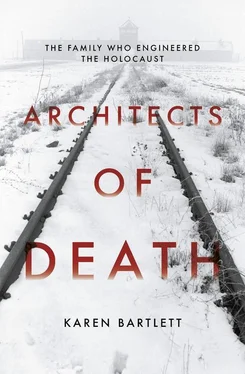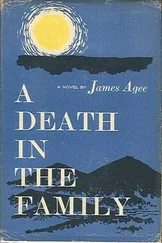With only one Crematorium In operation, however, Auschwitz-Birkenau is as yet unprepared to play a major role in the liquidation of the first Polish Jews – those mass murders will take place in the newly opened death camps of Bełżec, Sobibór and Treblinka. The SS leaders at Auschwitz must now scramble, under high pressure, to prepare their camp to take up the mantle of killing. In the summer of 1942, plans for building the new crematorium begin at a frenzied pace.
Although early gassing experiments at Auschwitz have been carried out in or near Crematorium I, this is quickly deemed an unsuitable site for a gas chamber, as the screams of the victims can be heard by other prisoners. Camp commandant Rudolf Höss finds a temporary solution to this by deciding to convert two farmhouses on the edge of the camp into makeshift gas chambers. In May 1942, the first farmhouse, known as ‘The Little White House’ goes into operation – it will be officially known as Bunker I. Bunker II, known as the ‘The Little Red House’, follows in June 1942. The SS estimates that 880 people can be murdered at one time in Bunker I, and 1,200 in Bunker II. With the bunkers now in operation, the mass transport of Jews to Auschwitz can begin and between May and December 1942 180,000 Jews from across Europe arrive at Auschwitz – more than 70 per cent of whom are immediately taken to the gas chambers.
Laurence Rees writes: ‘During 1941 the majority of the killing had been committed by special mobile units in the occupied Soviet Union; in 1942 the Operation Reinhard camps dominated the process of mass murder; but now three years after it was opened, it was Auschwitz’s turn to assume a central role.’ [81] Rees, op. cit., 2005, p. 215.
Yet, although Auschwitz is now ready to play a central role in the killing, it is still far from prepared for the disposal of the bodies of its victims. In July 1942, soon after the mass killings begin, the camp’s only working crematorium, Crematorium I, breaks down, with an SS report stating that the chimney is so badly damaged ‘due to constant overuse’ that it must be replaced. More people than ever are being murdered at Auschwitz, but cremation of their bodies is no longer possible. Under pressure, the only solution the SS can think of is to bury 50,000 victims in mass pits. This hastily thought up method is soon abandoned, however, as the decomposing bodies poison the groundwater for the surrounding area, and cause an overwhelming smell that sparks Himmler to personally order the pits to be reopened.
In light of this, Höss and his top henchmen visit other extermination camps in the east to see how others are disposing of their victims. After some investigation, Höss orders that the bodies should be burned in enormous piles in the open air, stacked upon layers of wood and doused in methanol. This grim process takes two months to complete.
As the SS are well aware, the only permanent solution to the new scaled-up system of mass murder is to urgently build new crematoria – and in the summer and autumn of 1942, Topf and Sons is undertaking this work as fast as possible under the leadership of Kurt Prüfer.
An agreement has already been reached to supply a new crematorium, Crematorium II, with five three-muffle ovens – and the building commences in the summer of 1942. In August of that year, however, Prüfer attends a crucial meeting with the SS at Auschwitz to discuss plans to build a further series of Crematoria (III–V) and refurbish Crematorium I. The details of this meeting on 10 August, kept on file by the SS Construction Management Office, reveal just how confident Prüfer was in his dealings with the SS, and the extent to which he acted out his role as the man to whom they could turn to solve their technical problems.
Prüfer meets with the deputy in charge, SS Untersturmführer Fritz Ertl, and two SS engineers Hand Kirschneck and Josef Janisch, as well as Robert Kohler who runs a local building company and has been commissioned to build the crematorium chimneys.
The meeting first discusses the deployment of Topf and Sons fitters Martin Holick and Wilhelm Koch to the camp to start work on installing the ovens for Crematorium II. Holick has been working on installing the three-muffle oven at Buchenwald, but Prüfer agrees that he can leave for Auschwitz as soon as that project is complete. Koch already has experience of working in Auschwitz after installing the double-muffle oven in Crematorium I in July 1940. These two men will work in the camp on the construction of all four crematoria.
The second item on the agenda picks up on discussions Prüfer has been having with chief of the SS Construction Office at Auschwitz, Karl Bischoff, about the ovens planned for the gas chambers at Bunker I and Bunker II. Prüfer has seen the technical drawings produced by the SS in which gas chambers are referred to as ‘special baths’ or ‘special cellars’. At the meeting he suggests that instead of installing two new three-muffle ovens, the camp could install an eight-muffle oven in each bunker from an unused order Topf and Sons had made for a camp at Mogilev in the Soviet Union. Prüfer is keen to get rid of unused stock that has been sitting in the Topf warehouse, but he justifies the sale on the basis that Auschwitz will be getting ‘the first large-scale oven’ produced by the company. [82] Schüle, op. cit., p. 163. AS footnote 45: Construction Management Dept, Building expenses book, ThHStAW, Collection Jean-Claude Pressac Nr. 42, sheet 42; Buchenwald Memorial Archive, Pressac Collection, sheet 775. Construction Management Dept, Advance Payments Book, p. 2, ThHStAW, Collection Jean-Claude Pressac Nr. 42, sheet 50, and Buchenwald Memorial Archive, Pressac Collection, sheet 783.
Discussing this agenda item alone Prüfer reveals that he not only has knowledge of the gas chambers, but that he is an active and enthusiastic participant in the SS’s plans for an even greater extermination programme.
The meeting then discusses the planned oven and ventilation system for Crematorium II, and concludes with Prüfer trying to persuade Auschwitz to keep an oven that has been shipped there mistakenly instead of to Mauthausen (the SS at Auschwitz decline to buy it).
All things considered, Prüfer must have left Auschwitz satisfied with the result of his negotiations. Three weeks later he makes a note of a phone call he has conducted with Hans Kammler, the deputy responsible for the SS Main Office in Berlin, in which Prüfer reiterates the increased performance the new ovens at Auschwitz will provide – using technical language to obfuscate the fact that increasing capacity from 250 per day to 800 per day refers to the disposal of the bodies of murdered human beings.
‘Prüfer approached the problems of the SS as though they were his own,’ Annegret Schüle writes. He ‘willingly came up with innovative ideas for the disposal of the victims of camp conditions, murder operations and the increasing, systematic extermination of human beings; and the company management supported him in this’. [83] Schüle, op. cit., p. 164. AS footnote 47: Kurt Prüfer makes note of a phone call for the company directors, 8 September 1942, ThHStAW, J A Topf & Söhne Nr 95, sheet 40. AS footnote 48: In later practice, the number of corpses cremated was significantly higher – up to 8,000 corpses per day across all the Birkenau crematoria, whereas Prüfer had assumed the number was only 3,200.
Indeed, not only did the company management support Prüfer’s department, Topf managers were even prepared to joke about it. With so much work outstanding at Auschwitz-Birkenau Prüfer calls a meeting with the head of the company’s planning department, Mersch, and the Topf and Sons operations director Gustav Braun. Prüfer later claimed that on the way to the meeting Braun had joked with him: ‘Boys, is there anyone left to burn there?’ [84] Braun–Prüfer head to head in Soviet Interrogation, Landesarchiv Thüringen - Hauptstaatsarchiv Weimar.
Читать дальше












